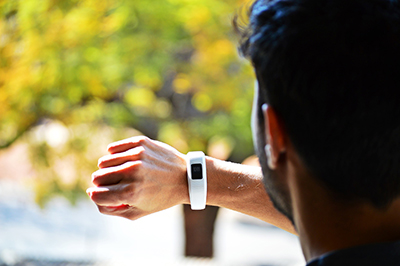How technology is changing the way we keep our hearts healthy

In a time when nearly half of American adults have heart disease, according to the Centers for Disease Control and Prevention, it has never been more crucial for people to make proactive decisions to support the health of their heart. While many are aware of the need to manage their blood pressure and cholesterol levels, serious issues including coronary heart disease and irregular heart rhythms continue to be common, and often overlooked, in people of all ages.
The good news is, as technology continues to advance, new tools and resources are emerging to empower us to make heart-healthy choices and have more meaningful conversations with our care providers. Although consumer technology isn’t meant for self-diagnosis, it does serve as a powerful way to help track personal health data and detect often-subtle heart symptoms. Here are a few technologies I’m seeing my patients use that have been monumental in managing their health from home:
Nutrition Applications: A healthy diet is one of the key ways you can maintain heart health, and there are a variety of mobile applications you can download on your smartphone to more easily track numbers such as caloric intake and nutrients. Apps such as ‘MyFitnessPal’ and ‘Lose It’ allow users to set goals for themselves, track progress with an easy-to-use electronic food diary, and engage with a community of users on health advice and tips. Overall, these apps are a great way to help people hold themselves more accountable in eating a balanced diet that includes nutritious heart-healthy meals.
Activity Trackers: Wearables have become a popular way to track daily physical activity, another key factor to maintaining a healthy heart. Connected wrist bands from companies, such as a Fitbit or Garmin, can track the number of steps you’ve taken or the number of calories you’ve burned each day. This tracking gives you a great way to measure progress against the activity goals you set for yourself. The average person should complete at least 30 minutes of moderate physical activity each day for five days each week, but I always recommend speaking with your healthcare provider to set personal goals that feel right and will lead to a healthier heart.
Apple Watch Series 4: In addition to simple activity trackers, wearable technology continues to advance and offer new tools to be proactive in your heart health. The Apple Watch Series 4 now offers a new electrocardiogram (ECG) application that can record your heart beat patterns and identify potential signs of atrial fibrillation (AFib), one of the leading causes of blood clots and strokes. Signs of AFib, such as shortness of breath or a fast heart rate, often go unrecognized by those who are experiencing them. With this new consumer ECG technology, people now have a new way to get even smarter about their heart health, uncover important symptoms, and make proactive decisions to seek help when needed.
As a cardiologist, it’s exciting to see new consumer technology emerging to empower patients and increase awareness of important health issues. If you’re interested in how this technology can support your cardiovascular health, I recommend visiting your primary care provider to discuss a plan that’s right for you. Pacific Medical Centers’ Renton clinic has a full-service cardiology clinic for more detailed heart testing and diagnosis. Your heart is the most important muscle in your body – now is the time to take proactive steps for a strong and healthy one for years to come.
Senior wellness: The best tips for your health this spring

Most people, especially seniors, tend to slow down during the winter, so spring—when nature is waking up again—is the perfect time to get moving. Whether you’re living independently, living in a senior community, living with a family member or caring for one, these spring health tips are sure to rejuvenate and inspire.
“Spring up” your diet by eating foods fertile in the spring season as a healthy way to shed those winter pounds naturally. Foods that are in season during the spring include leafy greens, strawberries, baby asparagus, and seasonal fish and shellfish.
To keep your body running at peak performance, it needs regular maintenance: a spring tune-up, so to speak. Dr. Lu Gao, board-certified internist at Pacific Medical Centers, offers the following tips:
-
- Keep warm as the season transitions from winter to spring. Even as temperatures start to rise, it’s important not to switch to spring/summer garments until outdoor temperatures stabilize.
- If you’re no fan of ice and snow, your whole world may expand once the spring sun settles in and thaws out the land. Stay active with daily outdoor exercises, ranging from 30 to 45 minutes. Moderate physical exercises are best to keep your heart rate at a safe range of 40–50 percent. These activities may include brisk walking or gardening, easily fitting into your daily routine.
- Be careful of obstacles to prevent falls both inside the house and outdoors. To be extra-cautious, use aids like walking sticks or canes whenever appropriate and possible. It is also important to ensure that footwear is securely on and supportive of your feet.
- Springtime can mean the beginning of allergies. If you suffer from seasonal allergies, take or continue your allergy medications, and be aware of pollen exposure during springtime. Pollen counts are the highest between 5 and 10 a.m., so try to reduce excessive exposure during that time frame by staying inside, wearing a mask or taking antihistamines.
- Stay hydrated. As we age, our ability to notice thirst may decrease, so it’s important to keep an eye on water intake, especially when you’ve been outdoors in the sun.
- Stay up to date on immunizations and other health screenings.
When your body is tired and your joints are sore, finding the motivation to be active is easier said than done. Even the smallest steps, however, can have a big impact on your overall well-being. Start with just one or two of these health tips and work your way up from there.
PacMed promotes two leaders to expand primary care

PacMed is proud to be keeping patient care at the center by expanding our primary care leadership to a team of Co-Chiefs. Drs. Alexander and Ivanjack will help us to adapt to the evolving health care landscape by re-shaping aspects of primary care delivery and operations, strengthening our care model and improving recruitment, all while maintaining their connection to patients by continuing to practice medicine.
These promotions fill a vacancy left by Dr. Betsy McCarthy’s return to medical practice full time. Drs. Ivanjack and Alexander each have served over seven years with the PacMed family.
Dr. Ivanjack trained at the Mayo Clinic School of Medicine in Minnesota with a focus on preventative medicine, chronic diseases and women’s health. She has been named one of Seattle’s Best Doctors by her peers the past four years running.
Dr. Alexander trained here locally at University of Washington and the Swedish Medical Center at the Indian Health Board, and focuses on well-child exams, women’s health and adult chronic health issues. She has written about fostering the primary care culture by nurturing patient relationships over time, gaining rich insight to help tailor health recommendations and diagnoses to each individual patient.
Learn more about our new Co-Chiefs:
Lise Alexander, MD
Lisa Ivanjack, MD





